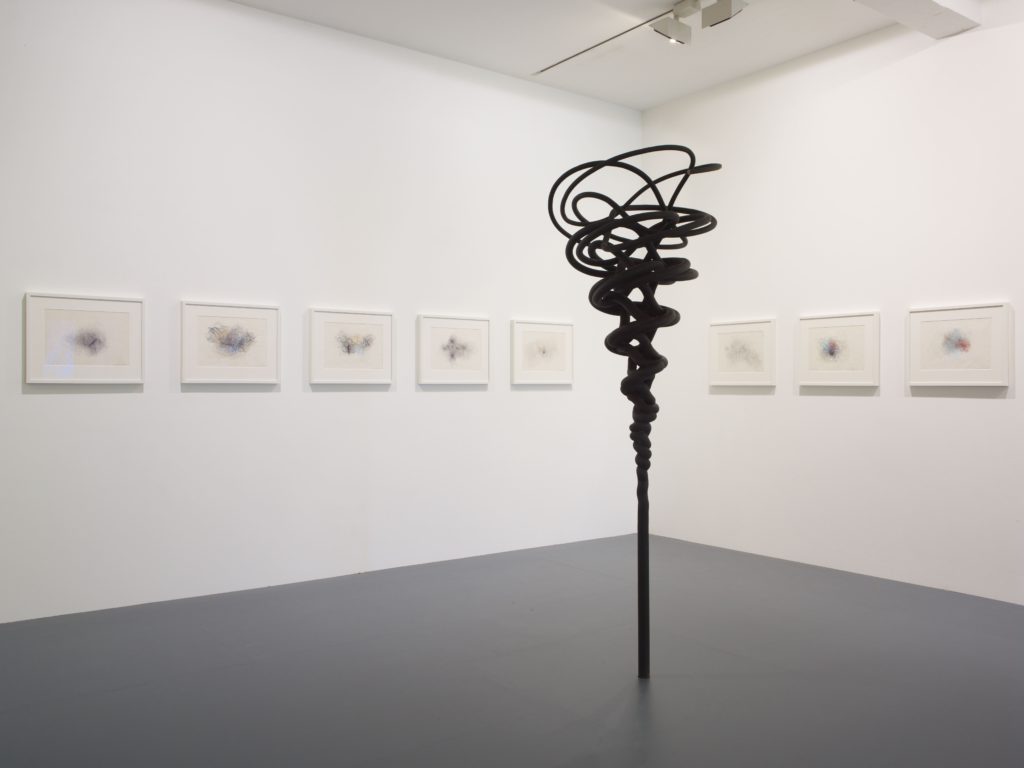
Lines of Thought
29 February - 13 May 2012
The exhibition Lines of Thought explores the work of 15 contemporary artists, whose practice has focused in particular on using line in creatively challenging ways. With works representing different generations, it is remarkable to observe how the meaning and use of line varies from one artist to another.
Simply the running on of a point, line is paradoxically one of the most powerful means of expression. Continuous or broken, curved or straight, free-floating or geometric, lines can define boundaries, divide spaces, create light and shade, or be used for communication. Throughout the history of art, line as a basic element of artistic expression has been used by many artists to explore and express a wealth of feelings, thoughts and ideas.
Combining European and American traditions of post-war art, James Bishop’s poetic and reductionist geometry abandons the hard-edge abstraction of many of his contemporaries. Raoul De Keyser’s ambiguous, gestural minimalism seems not only to merge various contradictory elements – figuration and abstraction, gesture and geometry – but also to inspire long contemplation of it. Being of the same generation as Bishop and De Keyser, Indian artist Nasreen Mohamedi’s sparse work remains surprisingly under-recognised in the west. Her work is characterised by a total and coherent commitment to the language of abstraction, while her austere drawings evoke an atmospheric and delicate sensibility.
One of Britain’s most influential living artists, Richard Long has put his journeys in nature at the heart of his work since the mid-1960s. Even when exhibited indoors, Long’s works have a strong, organic feel to them that reflects the artist’s connection to the landscape. While the work of Sol LeWitt, Fred Sandback and Anne Truitt is largely related to Minimalism, the intimate works of Richard Tuttle evolve out of a radical reduction of the composition elements.
The artistic concerns of the younger generation are infinitely varied. The Turkish team, Özlem Günyol and Mustafa Kunt make clever use of line to comment on national identity and geopolitical issues with, for example, the background lines of different passports and the meaning of lines that represent borders between countries. American artist Adrian Esparza, born and raised in El Paso, Texas, also comments on political divides, garnering much of his source material and inspiration from his borderland experiences. In his newly made work, Esparza mounts a Mexican serape [blanket] on the wall, then partially unravels it. Inspired by historic landscape paintings he guides the cotton thread through a grid of nails to create a primarily geometric design. The artist’s process of deconstructing the source results in a vibrant optical experience which simultaneously unveils the history it represents.
Refusing to be pushed into any category of art history, Jorge Macchi makes works that provoke thought about everyday questions and offers startling perceptions with a minimum of form. Helene Appel uses selected gatherings of everyday items to make meticulous abstractions that inspire contemplation. Walking the line between art and science, Conrad Shawcross’s sculptures explore subjects that border on geometry, philosophy, physics and metaphysics. Finally, the Indian artist Hemali Bhuta’s often site-specific installations function both as ephemeral objects and documentation in ways that can seem contradictory. Her dramatic and impressive installation Stepping down, 2010, includes several thousand stalactites that simulate candles and engender a cave-like experience.
This exhibition is accompanied by a full-colour publication.
The exhibition is kindly supported by: Mr Kishore & Mrs Manju Lulla; Fayeeza & Arif Naqvi; ZVM Rangoonwala Foundation; Berna-Tolga Tuglular and those who wish to remain anonymous.













